1945: Something new has been added!
The production schedule is shrinking... For the first time since 1931 (and also the last time for a while), the number of the Looney Tunes and Merrie Melodies shorts falls below the 20-mark. But there will be some milestones in the series, and the additional commissioned shorts will again form a notable part of the studio's output...
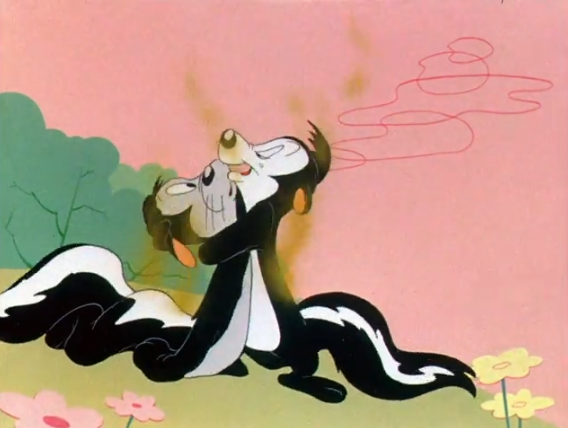
Odor-able Kitty
Directed by Charles M. Jones
A cat is unsatisfied with the way he gets treated. He comes up with a solution – with the help of paint and stinky foods, he disguises as a skunk. It works, since he no longer gets chased by dogs and can have all the meat he wants from the local butcher shop. But it all goes wrong when a real skunk mistakes him for a female skunk and falls for him. The first appearance of Pepé Le Pew (called Henry in this cartoon), who would become Jones' most popular introduction to date. The skunk pretty much has his final personality here, with his amusing French accent and strange way of hopping around. And in what would be a rather formulaic series, I think this is among the stronger entries – some great gags (including a surprise cameo!) and an especially great ending.
9.5
Herr Meets Hare
Directed by I. Freleng
Bugs gets lost on the way to Las Vegas and ends up in the Black Forest where Hermann Göring is hunting. The bunny saves himself by taking up various costumes to fool the hunting Nazi. Another great wartime cartoon – Bugs shines in various roles, including Brunhilda (a role repeated later in a more famous cartoon). Bugs had already made a reference to Albuquerque two years earlier in "Jack-Wabbit and the Beanstalk", but this cartoon contains the first occurrence of the line "I knew I should've made a left turn at Albuquerque", used in many later Bugs cartoons. While this cartoon is rarely shown due to its subject matter, it's quite an influential entry, as well as one of the most memorable wartime shorts!
10
Draftee Daffy
Directed by Robert Clampett
Daffy is cheering the latest U.S. military successes, but his patriotism disappears when he hears he's getting a letter from the Little Man from the Draft Board. Despite his best attempts, Daffy can't seem to get away from him. One of the wackiest cartoons we've seen so far – Daffy's portrayal may be at odds with that in his previous wartime shorts, but otherwise, he's the familiar crazy duck. The Little Man from the Draft Board is also an entertaining character with his understated personality and one-liners. Brilliant animation by Rod Scribner and the rest of the Clampett crew, fast-paced action and a surprising but funny ending. A nice goodbye to the WWII-themed cartoons, as we won't be getting any more in the main series (not counting some occasional gags).
10
The Unruly Hare
Directed by Frank Tashlin
Railroad worker Elmer Fudd takes a break in nature, but his plans to relax are ruined by Bugs who plays tricks on him. The rabbit starts doing more and more to annoy Elmer after he tries to shoot him. Another great cartoon with the various pranks from Bugs, really bringing Elmer to his wits' end. Tashlin's first Bugs cartoon shows he immediately got the character right (most directors seem to do great with him!) – while Bugs is less innocent than in some of his cartoons (he's the one to start annoying Elmer here), Elmer's attempts to shoot him make his actions much more justified than in "The Wacky Wabbit", for example.
9.5
Trap Happy Porky
Directed by Charles M. Jones
Porky is staying in a cabin but can't get any sleep due to two mice (Hubie and Bertie) making a lot of noise. A cat manages to get rid of the mice, but that doesn't end the noise problem... A fun cartoon based on repeated occurrences of the same problem with funny variations. The theme isn't a new one (Porky's sleep was previously disrupted in "Porky's Badtime Story", its remake "Tick Tock Tuckered", and "Notes to You"), but this is different enough to not feel too much like a remake. The ending is also a fitting one.
8.5
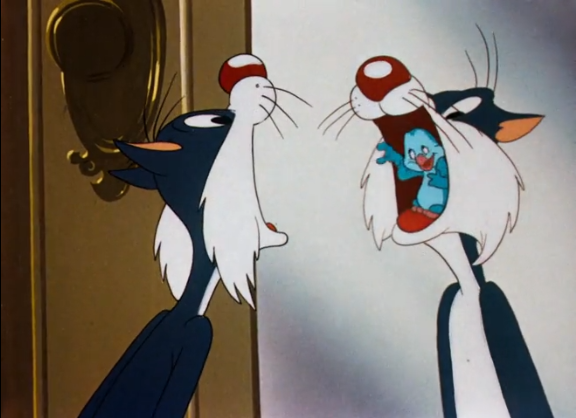
Life with Feathers
Directed by I. Freleng
After being thrown out by his wife, a lovebird decides to end it all. He tries to get eaten by a cat, but the cat immediately assumes the bird is poisoned and trying to kill him. The cat desperately tries to get away from the bird. Most notably, this is the first appearance of Sylvester – the cat didn't have a name yet and had a slightly blue tint to his fur, but the character is otherwise the one we know and love, with his familiar voice and catchphrase "Sufferin' succotash". Despite the dark theme, this is a great short with funny gags and a twist ending. The lovebird is quite a likable character, though Sylvester of course steals the show – not hard to see why he would become one of the most popular characters in the series! This cartoon also brought the studio an Oscar nomination, but the win went to yet another Tom and Jerry short, "Quiet Please!"
10
Behind the Meat-Ball
Directed by Frank Tashlin (uncredited)
Fido the dog is hungry and wants meat, not vegetables ("Bugs Bunny food"). After various meat mirages, he misses out on a real steak that fell out of a meat truck, as it gets snatched by a little dog. This eventually leads to a fight between three dogs for the steak. A fun cartoon with an entertaining trio of dog characters – sillier and more cartoony than the Curious Puppies shorts that were somewhat similar in idea. The end gag is my favorite part!
9
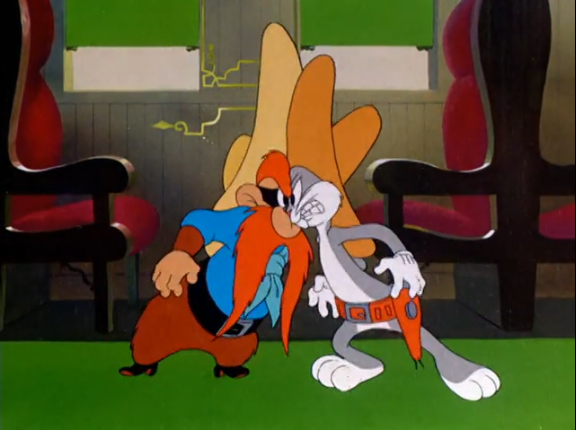
Hare Trigger
Directed by I. Freleng
Bugs Bunny is traveling on a train when the notorious robber Yosemite Sam strikes. The tough little guy won't have it easy, though, with Bugs constantly outsmarting him. This is Sam's first appearance – the character immediately impresses with his short-fused personality and distinctive mannerisms, and has excellent chemistry with Bugs. The gags in this one are great, there's wordplay and even some use of live-action footage. The ending, while somewhat similar to the one in "My Favorite Duck", is still a funny and appropriately random one.
10
Ain't That Ducky
Directed by I. Freleng
A hunter is after Daffy, but an angry yellow duckling with a suitcase keeps getting involved in the action. The other two characters soon get interested in what's in the suitcase... In this short, everyone seems to be pitted against the others at some point (Daffy helping the duckling escape from the hunter, the duckling telling the hunter where Daffy is...) The duckling is amusing despite being slightly one-note, and then there's the eventual revelation of what the suitcase actually contains. A fun cartoon.
8.5
A Gruesome Twosome
Directed by Robert Clampett
Two cats (one yellow, the other orange) are fighting for the company of an attractive female cat. She says she'll date the one that manages to bring her a bird. The two then fight over Tweety, before collaborating to catch him. This is another great short, building upon the ideas introduced in the first two Tweety cartoons. He still has his original design and personality (this time, a bee and a dog also get caught up in his violence towards the cats). The cat characters are also funny, especially the orange cat with his Jimmy Durante impersonation, and they engage in plenty of good old-fashioned cartoon violence. Wacky gags, including fourth wall breaks and clever jokes snuck past the censors, and the great lively animation often seen in Clampett's cartoons. The last short with the original version of Tweety is definitely worth a watch, just like the first two!
10
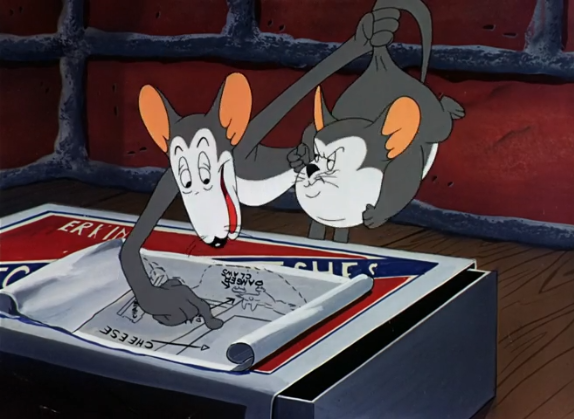
Tale of Two Mice
Directed by Frank Tashlin (uncredited)
Babbit and Catstello from "A Tale of Two Kitties" return, though they're now mice instead of cats! Babbit wants some cheese and forces Catstello to carry out various schemes to get it for him despite his fear of cats. But all these schemes end with Catstello (and sometimes Babbit too) in danger. The characters are amusing just like they were on their debut, maybe even more so this time (Tweety having stolen the show last time around). The loud and obnoxious Catstello is actually the more likable of the two, with Babbit being quite mean to him. The cartoon is a fun take on the traditional cat and mouse theme, with the ending being a particular highlight!
9.5
Wagon Heels
Directed by Robert Clampett
A color remake of "Injun Trouble" from 1938. The story of how the United States took over Injun Joe's territory. Porky is on the lookout for him, soon encountering the secretive hillbilly Sloppy Moe (now finally given a name). Like I've said with the two earlier remakes, this is a cheap and quick way to make a cartoon. But unlike the first two (especially the underwhelming "Slightly Daffy"), I find "Wagon Heels" a vastly improved cartoon in comparison to the original one. Besides the refined animation and character designs, there are many new gags (like the classic "I'm only three and a half years old" line) and narrative elements added, some scenes have been rearranged, a new ending... Some scenes were also removed, though apart from maybe the surreal scene of Injun Joe eating a mountaintop like an ice cream dish, the scenes in question weren't particularly noteworthy. Add to this a new and improved soundtrack, and this becomes the cartoon the original should have been in the first place.
9
Hare Conditioned
Directed by Charles M. Jones
At a department store, Bugs is part of a demonstration that will be replaced with a new show. He finds out he'll be moved to the taxidermy department – stuffed! He has to escape from the manager. Another entertaining one, with Bugs outwitting the manager in various ways. The cartoon gets better as it goes on, with another amusing ending.
9
Fresh Airedale
Directed by Charles M. Jones
A dog is man's best friend... or at least it seems so. Shep the dog eats his owner's roast, but the cat ends up getting the blame for it and is kicked out. And this is not the only time it happens – the dog is bribed by a burglar, but when the cat stops him, the dog's the one that takes credit for it. This keeps happening to the heroic cat and the villainous dog. A fascinating cartoon – an extremely bitter story about how good doesn't always win. Jones' recognizable visual style and expressions add to the characters' portrayal. The cat is very sympathetic, while the dog is among the most unpleasant characters in the whole series. There's also an experimental nightmare sequence with stylized animation. From what I've read, this is among the most divisive shorts in the series due to its subject matter – a short that some love and others absolutely despise. I'm in the former group, though I can't help but wonder what could have inspired the crew to make such a commentary on the unfairness of the world...
10
The Bashful Buzzard
Directed by Robert Clampett
Once again, the mother buzzard sends her kids out to bring something for dinner. Killer (or Beaky) is again reluctant, and while the others bring home big animals, he struggles with his attempts to bring even a baby bumblebee. In concept, this is very similar to "Bugs Bunny Gets the Boid", just without Bugs. The first couple of minutes have essentially the same content as in that cartoon, but thankfully it diverges then, with some funny new gags, including one referencing a recent Disney film, and a line that got past the censors. Very entertaining despite its slight derivativeness!
9.5
Peck Up Your Troubles
Directed by I. Freleng
Sylvester is back, and this time he's after a woodpecker. However, the little bird keeps defeating the cat with both his ability to peck and his cleverness. While Sylvester had already appeared once, in some ways this feels more like his later cartoons than "Life with Feathers" did – he's trying to catch a bird living in a tree, the gags are short and fast-paced, and there is even a dog foiling his schemes in some of the scenes. One oddity is that Sylvester is mute (despite having had his familiar voice in his debut cartoon), which I find the only notable flaw of the cartoon (the usual voice being such a crucial part of his character). The woodpecker character is a likable one, and we even get an example of some entertaining cartoon logic. An early effort, but a very enjoyable one.
9.5
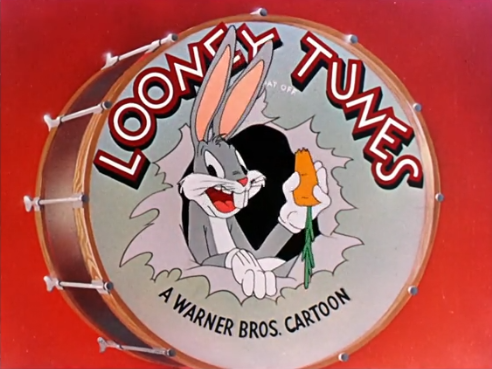
Hare Tonic
Directed by Charles M. Jones
Elmer buys a rabbit, planning to make rabbit stew. But Bugs decides to have some fun with the guy, managing to convince him that all the rabbits sold in the last three days are infected with the contagious disease rabbititus. Elmer desperately tries to get away from the supposedly contaminated rabbit and soon starts to experience the symptoms... One of Jones' best cartoons so far – comparing this to his first Bugs cartoon "Elmer's Pet Rabbit" (which similarly has Bugs staying in Elmer's house) shows how much his style has changed and improved. The gags are funny, the chemistry between the characters works really well, and especially Bugs gets to shine in his role. Symbolizing Bugs replacing Porky as the studio's big star (and also perfectly fitting the last gag of the cartoon!), he gets a Looney Tunes end title of his own, though this would only appear in two Bugs cartoons (the following year's "Baseball Bugs" being the second one) before the classic drum ending was retired.
10
Nasty Quacks
Directed by Frank Tashlin (uncredited)
A father gave her daughter Agnes a duckling, but the now grown-up Daffy has proven an absolute nuisance to him. He tries to get rid of the annoying duck, but Agnes objects to losing her funny pet. Not quite one of Daffy's or Tashlin's strongest, but enjoyable in any case – the wacky duck and the angry man have an entertaining rivalry, and the daughter is also a funny character representing the then common talkative character archetype. Another funny ending – probably my favorite gag in this one!
8.5
Five more Private Snafu shorts produced by the studio were released in the Army–Navy Screen Magazine this year. Directors were once again uncredited.
In the Aleutians – Isles of Enchantment
Directed by Charles M. Jones
A spot gag cartoon about the U.S. island bases on the Aleutian Islands, the wildly changing weather conditions and how soldiers cope with them (the running gag featuring Snafu constantly changing his clothes to more weather-appropriate ones). This has some good gags featuring the soldiers, but it's not one of the strongest in the series (and it's another one where Snafu himself doesn't appear much).
7.5
It's Murder She Says...
Directed by Charles M. Jones
Malaria mosquito Anopheles Annie tells the story of her golden days and how they came to an end when the military started to combat malaria. But fortunately for her and her fellow mosquitos, there are still some soldiers like Snafu! I can sense the writers were starting to run out of ideas for Snafu himself, as this is yet another short where he plays a fairly small role. The mosquito and her story are interesting, though – a nice way to promote the importance of fighting malaria.
8
Hot Spot
Directed by I. Freleng
The devil himself hosts a spot gag cartoon about how lend-lease products are delivered to Russia through Iran, despite the scorching heat (too hot even for the devil). Snafu is one of the hard-working soldiers involved, with some of the typical misfortune befalling him. Another average but enjoyable entry, and (surprise!) yet another one where Snafu himself doesn't appear much. Some entertaining cartoon physics here (even a train going through a painting of a tunnel – a variation of which would be a later Chuck Jones favorite!), though of course Snafu fares worse with them than the other soldiers.
8
No Buddy Atoll
Directed by Charles M. Jones
Snafu and a soldier from the Japanese navy end up on a desert island together. The latter is armed with a sword, but Snafu manages to outwit him despite his inferior weapons. This late entry takes a new approach to the Snafu series – the soldier is no longer the incompetent, hapless one from the previous shorts, but actually clever enough to survive a dangerous situation (and it's not a dream like in some of the earlier shorts). The Japanese soldier's portrayal is predictably stereotypical, though thankfully not quite as bad as in the most offensive cartoons of the era. This is among the most Looney Tunes-esque shorts of the Snafu series with its chase sequences and comedic action.
8.5
Operation Snafu
Directed by I. Freleng
The last released Private Snafu cartoon produced by Warner Bros. Cartoons. In this mostly dialogue-free cartoon, Snafu is in Japan, trying to steal their war plans. He fools the soldiers by dressing as a geisha. As with the previous entry, this is very much in the Looney Tunes spirit and features a more competent Snafu. It's an entertaining one with its mostly pantomime approach and some daring scenes, though I feel the opening scene with the Japanese soldiers carrying the files around is a little too long and repetitive.
8
A further Snafu short called "Secrets of the Caribbean", directed by Chuck Jones, was also made but never released due to the end of the war. No copies of it are known to exist today.
A few shorts featuring Snafu were also made this year by other studios. The soldier appeared in the "A Few Quick Facts" entries "About Fear" produced by UPA, as well as "GI Bill of Rights" and "Voting for Service Men Overseas" by Disney. Like the non-WB Snafu cartoons last year, these were informative shorts with limited animation and little comedic content. But the actual Private Snafu series was now also worked on by other studios in addition to WB. The last released cartoon featuring the character was "Seaman Tarfu in the Navy", produced by Harman-Ising and released in early 1946. This short was closer to the comedy of the WB shorts (especially in the end gag!) despite the slightly weaker animation and focusing on Snafu's brother rather than the usual main character. A short called "Mop Up" by MGM was also in production but never finished.
Warner Bros. Cartoons also started producing shorts featuring the character Mr. Hook for the U.S. Navy. The character was created by Hank Ketcham, who would later create the famous comic strip Dennis the Menace. Hook had made his animated debut in a 1943 color short by Walter Lantz Productions, "Take Heed Mr. Tojo", where retired seaman J.M. Hook told the story of how he defeated a Japanese jet pilot using war bonds. The WB shorts, likewise promoting war bonds, were in black and white and shorter (just three to four minutes in duration) but with higher-quality animation. Just like in the army cartoons, the directors weren't credited in the films.
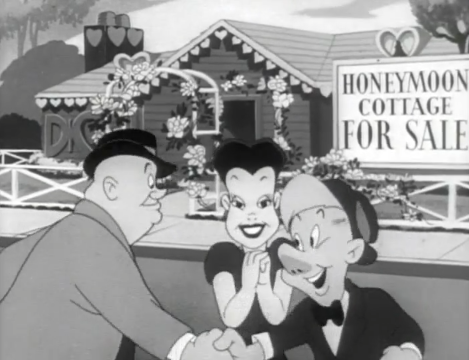
The Return of Mr. Hook
Directed by Robert McKimson
Hook buys war bonds, but his buddies in the navy make fun of him for it. He then tells them about his post-war plans, making an impression on all the other sailors. While primarily a war bond ad (even featuring the song "Any Bonds Today?", previously sung by Bugs Bunny) with more of a PSA feel to it than the Snafu cartoons, there are enough funny little gags to make this an entertaining watch. For the smart character in the short, Hook is portrayed as surprisingly goofy. This was actually McKimson's first directorial work before any of his Looney Tunes and Merrie Melodies.
8.5
The Good Egg
Directed by Charles M. Jones
Not to be confused with the 1939 Merrie Melody (also directed by Jones) featuring chickens and a turtle! The traditional conscience fight, as a devil tries to convince Hook to spend his money on a good time instead of war bonds, while an angel tells him bonds are a good purchase. The latter demonstrates this with a literal nest egg. Nothing groundbreaking but I think this is a charming way to present the message. Jones' recognizable style adds to the appeal.
8
Tokyo Woes
Directed by Robert Clampett
Japanese radio propagandist Tokyo Rose tries to convince Americans that war bonds are worthless. But Hook doesn't fall for it! A more comedic cartoon than the previous Hook ones, but with badly dated stereotypes also thrown in. The wild animation doesn't completely make up for the more annoying aspects of this short (I don't really like the characters here, especially the stereotypical ones). I like that they attempted to include more humorous content this time, but some of it unfortunately falls flat.
7.5
A training cartoon series called "Grampaw Pettibone's Gripes" was also produced for the U.S. Navy. While at least two shorts ("Join-Up Collisions" and "Fuel Tank Selection") were made by UPA, only one is known to have been made by the WB cartoon studio, likely with Frank Tashlin directing. The lead character was designed by Robert C. Osborn, and kept appearing in Naval Aviation News columns until the 1990s.
Dive Bombing Crashes
There has been an increase in fatal crashes in dive bombing practice, due to pilots not paying enough attention to their altimeter. Grampaw Pettibone, a veteran, tells the audience what they should remember in order to avoid these crashes. While I don't think this has the entertainment value of the Private Snafu or even the Mr. Hook shorts, it's slightly more captivating than UPA's takes on the same character. A couple of short gags, with stylized animation for the crash sequences (in this regard looking similar to the UPA shorts). Fairly effective from an informative point of view, but today, it's pretty much just a curiosity.
7.5
While the later Snafu shorts showed a slight decline compared to the earlier ones, the main series retained a very high quality once again. Despite having fewer shorts than in the previous years, this was an unusually important year for the Looney Tunes and Merrie Melodies, introducing three characters that would all become very popular. With the wartime cartoons now out of the way, one could say the WB cartoons are about to reach their definitive era...
-
 2
2



4 Comments
Recommended Comments
Create an account or sign in to comment
You need to be a member in order to leave a comment
Create an account
Sign up for a new account in our community. It's easy!
Join the herd!Sign in
Already have an account? Sign in here.
Sign In Now